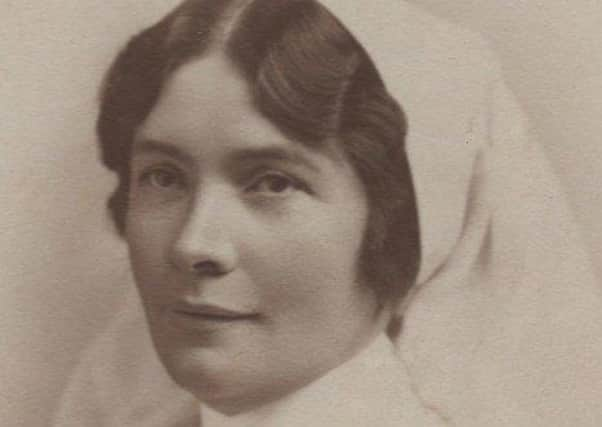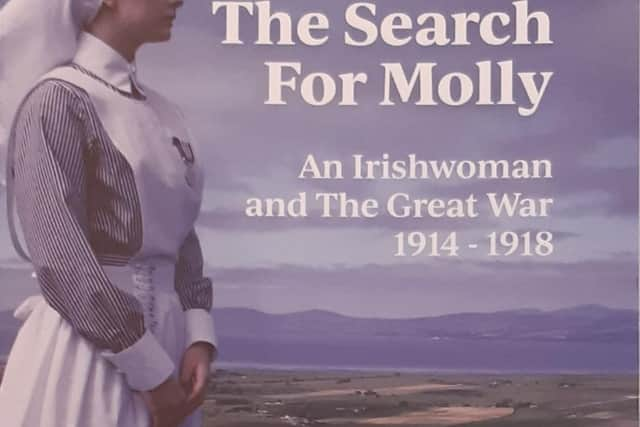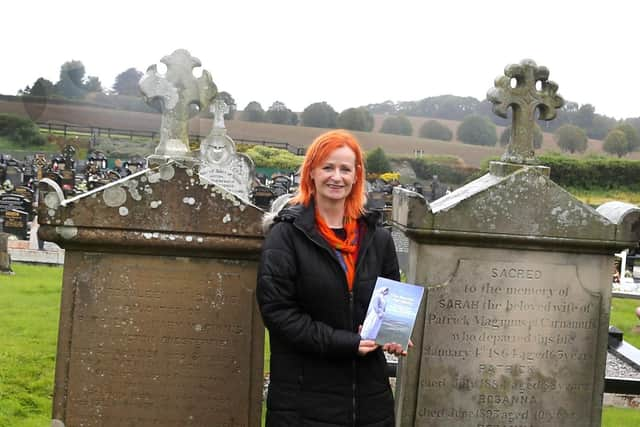WWI Military Medal: The night Co Londonderry nurse Molly McGinnis didn’t run away


As bombs rained down around her and the hospital in which she worked came crumbling down, a nurse from Co Londonderry ‘didn’t run away’.
It was those selfless actions, in putting her patients first, that earned Molly McGinnis – a quiet, unassuming woman from a farm in the hills above Carrichue – a Military Medal for her actions during World War One.
Advertisement
Hide AdAdvertisement
Hide AdHer story is told by Rosemary Henderson, Molly’s great niece, whose aim is to bring into focus the unsung women who had key roles to play during the Great War.


Rosemary was part of a history group in Ballykelly who submitted a project to Causeway Coast and Glen Borough Council entitled Understanding Your Neighbourhood.
She said: “The original project was about the unsung women of the local area [during World War One] – the women who collected the moss, cut the bandages, knit the socks. The women who never left their mark on history.
“With budget cuts and various things it was pared down to Molly’s story. I thought, ‘there’s not enough to write a book about Molly, a pamphlet maybe’.
Advertisement
Hide AdAdvertisement
Hide Ad“We were chatting as a family recently and I was saying in the end I’ve left out almost more than I put in. I was too close to Molly’s story, I couldn’t see the wood for the trees.”


Rosemary said: “I had always done genealogy and family research. My two sons would tell you I trail them around the cemeteries and all that.
“I always bend my mother’s ear about information. My sisters are like, ‘here we go again, out comes the notebook’.
“I didn’t just want to find the dates and names and put them on a family tree. I want to know how they lived, what their influences were. I want to know their social history, what they might have thought.”
Advertisement
Hide AdAdvertisement
Hide AdShe continued: “I did meet Molly as a child. I wish I’d been maybe 15 years older. I was eight when she died.
“We would have visited and stayed with my aunt who was looking after her.
“I remember her being very kind and softly spoken. I was too young to know anything about her story.”
Molly was awarded a Military Medal for her actions on the night of May 31, 1918 in the St John’s Ambulance Hospital in Etaples, France, one of a number of hospitals in the area caring for wounded soldiers on the Western Front.
Advertisement
Hide AdAdvertisement
Hide AdRosemary told the story: “She was on night duty. The St John’s Ambulance Brigade Hospital was right next to the railway line. Etaples was the target and it was on the railway line.
“There’s stories that the Germans must have known about the hospital. It was a clear enough night, all the roofs were marked with the red cross, but they continued to bombard it.
“The village itself was decimated by bombs the night before, the people abandoned it overnight and went into the hills. Because they were near the railway line they got the brunt of the bombardment that night.
“It basically demolished the hospital. The photographs that exist show that one hut was left standing where the x-ray and operating theatre was. There was one South African nurse killed. A lot of orderlies were injured. They managed to get a lot of the patients out.
Advertisement
Hide AdAdvertisement
Hide Ad“Molly was on duty that night. She secured a ward and dug out the patients out of the rubble. She stayed at her post.
“She’s reported, anecdotally from some other nurses at the time who did keep diaries, to have thrown herself across the bed of a patient to protect him as the ward collapsed.
“That has been reported back a few times though it’s not mentioned in the dispatch for the Military Medal, just that she stayed and comforted her patients.
“Years later she was quoted as saying ‘I got a medal because I didn’t run away’. That’s all she ever said about the medal.
Advertisement
Hide AdAdvertisement
Hide Ad“She did talk about her time in France as a nurse but the only reference to the medal, and that night, was that she didn’t run away.”
The citation in the London Gazette, July 1918, read: “For gallantry and devotion to duty during an enemy air raid. She showed great courage, took charge of a ward, and sustained her patients.”
Rosemary said: “I have her medal. My uncle gave it to me. I nearly died. He said, ‘you’re the only person showed any interest in her’, and he gave me the medal along with quite a few bits and pieces that he had.”
Sister Molly McGinnis was one of only 147 women awarded the Military Medal during World War One, just nine of whom were Irish.
Advertisement
Hide AdAdvertisement
Hide AdAfter the hospital in Etaples in which she worked was destroyed, Molly moved further down the coast to the rebuilt hospital.
Rosemary said: “St John’s was considered the best equipped hospital in France at one point, they were the only people who had a cardiologist.
“When they moved further down the coast they were getting the rehabilitative patients before they went back to England. They had been getting the very serious patients before that in Etaples.
“Colonel Trimble who was in charge, he wrote that he kept the staff who he felt deserved the honour of being the last to leave. Molly would have been among the last to leave along with the last half dozen or so patients.
Advertisement
Hide AdAdvertisement
Hide Ad“When they demobilised the hospital they donated the radiography equipment to the Royal and Queen’s University got all the x-ray records. The staff in from Northern Ireland, or the north of Ireland as it was then, had been instrumental in setting up the hospital.”
After leaving France in 1920 Molly came back to Dublin: “Red Cross records indicated that she wanted to retrain in midwifery. I think she’d had enough of death. Her and her friends set up a nursing hospital in Dublin.
“In her later years she went to work for a private contractor, for a family who had a relative who wasn’t well.
“She retired to Belfast, a residential retirement home, two weeks later she lifted the phone to my uncle and said, ‘can I come home?’
Advertisement
Hide AdAdvertisement
Hide Ad“She left Ballykelly in her late 20s. She came home her in her later years and died.”
Rosemary commented: “There are still gaps in her story. What she did between 1940 and 1950. It felt like she came back from the war and then retired. I know there’s so much more.
“If we ever get out of the Covid restrictions I’ll be away back down to the museums again to go through their papers.”
Rosemary said her family contained some more “very interesting people” including Molly’s nephew who was a British diplomat in New York and her older brother who was a GP in Dublin. She also had another brother who was interned in the 1920s.
Advertisement
Hide AdAdvertisement
Hide AdThe Search For Molly: An Irishwoman in the Great War 1914-1918 marks the culmination of many years of research by Molly McGinnis’s great niece, Rosemary Henderson.
The publication was made possible by Causeway Coast and Glens Borough Council’s PEACE IV Local Area Action Plan, funded by the European Union’s PEACE IV Programme, managed by the Special EU Programmes Body (SEUPB), which is providing £3.8m for community projects across the borough.
The story is the final publication of the Understanding our Area Decade of Anniversaries project, which also included ‘1918 Local Voices’ and ‘Partition in Ireland: Partition of Ulster’.
The book was launched just before the latest lockdown on September 30 last year – the anniversary of Molly’s death.
Advertisement
Hide AdAdvertisement
Hide AdThe event saw the Mayor of Causeway Coast and Glens Borough Council, Alderman Mark Fielding, joined by family members and representatives of Museum Services and Peace IV at Molly’s graveside in St Finlough’s Graveyard, Ballykelly.
The book is available on the NI Community Archive (www.niarchive.org)
A message from the Editor:
Thank you for reading this story on our website. While I have your attention, I also have an important request to make of you.
With the coronavirus lockdown having a major impact on many of our advertisers - and consequently the revenue we receive - we are more reliant than ever on you taking out a digital subscription.
Advertisement
Hide AdAdvertisement
Hide AdSubscribe to newsletter.co.uk and enjoy unlimited access to the best Northern Ireland and UK news and information online and on our app. With a digital subscription, you can read more than 5 articles, see fewer ads, enjoy faster load times, and get access to exclusive newsletters and content. Visit https://www.newsletter.co.uk/subscriptions now to sign up.
Our journalism costs money and we rely on advertising, print and digital revenues to help to support them. By supporting us, we are able to support you in providing trusted, fact-checked content for this website.
Alistair Bushe
Editor